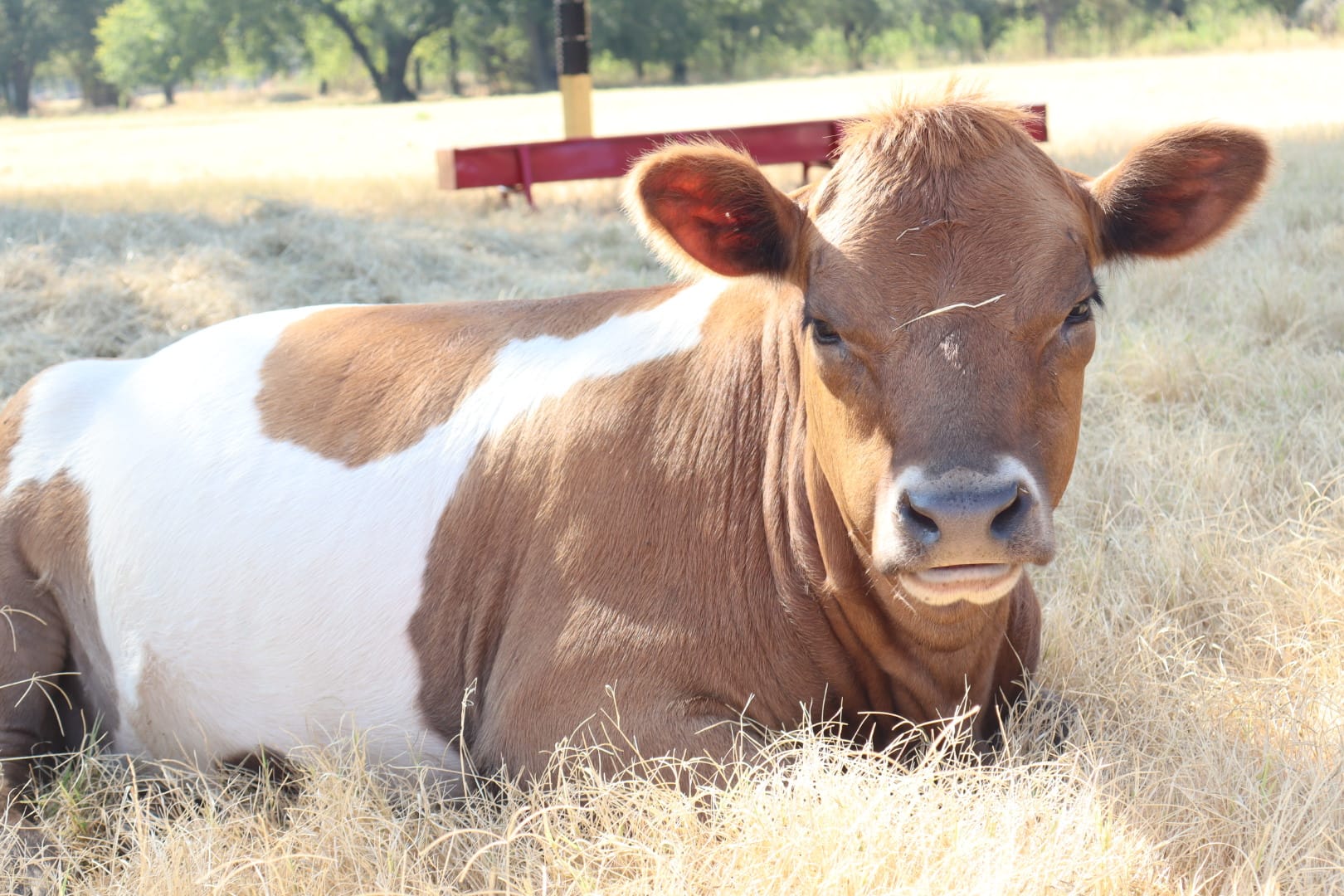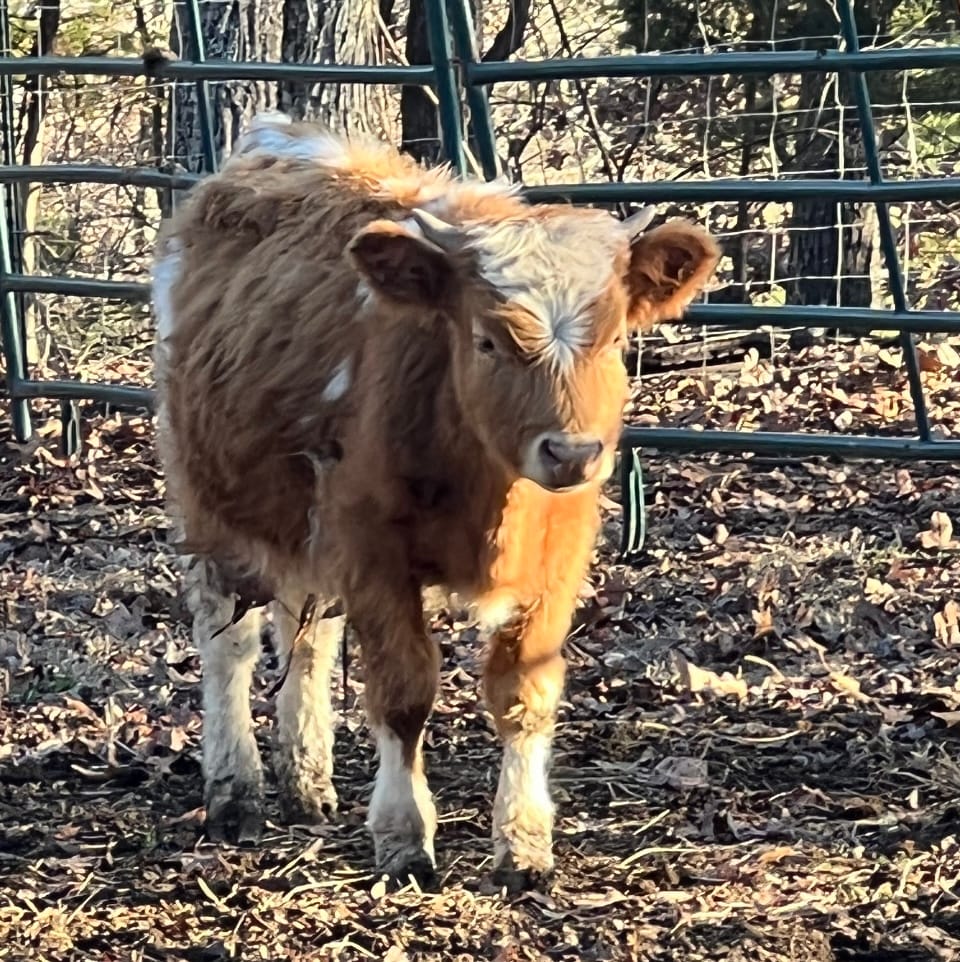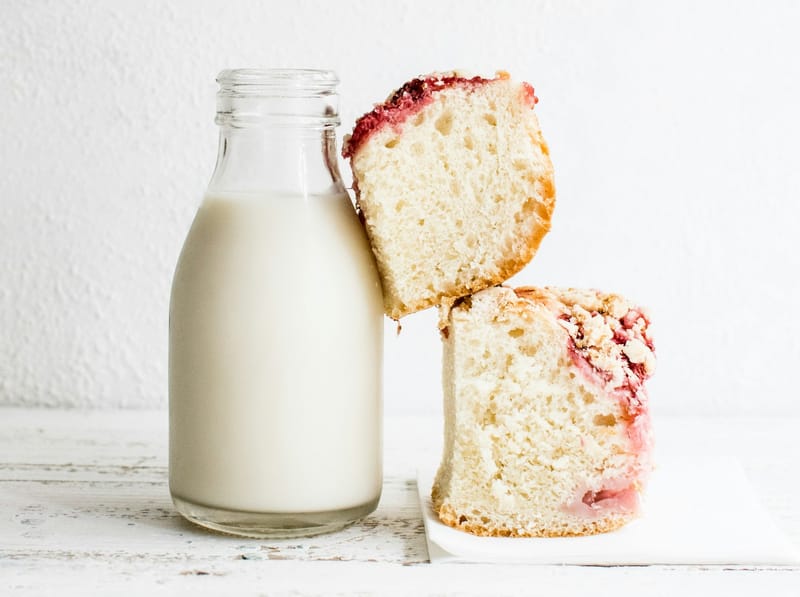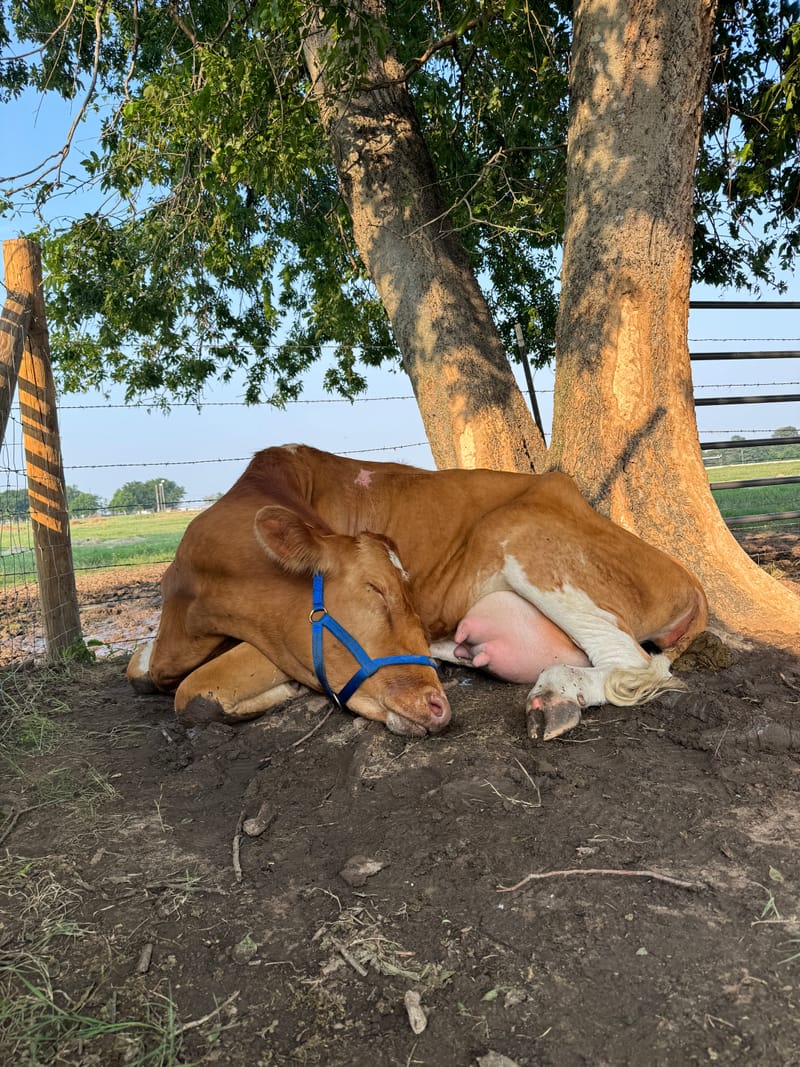Our herd is made up of a variety of different cattle breeds and it's all intentional.
I've spent hours reading research papers, speaking to those in the industry, and reading forums & blogs to learn as much as I can about cattle breeds. And then I read "Keeping a Family Cow" and I instantly knew exactly what the purpose of my herd would be—adorable, smaller sized cattle that provide families with yummy, purposeful milk & heart-healthy, high-quality beef, all while being beautiful yard art.
Why All the Different Breeds?
When you cross a dairy breed with a beef breed, you can produce a fantastic cross breed that better aligns with family homesteads needs and produces a higher-quality, healthier cow. Among many other benefits!
In one of my early cattle purchases, I purchased a mini Jersey Belted Galloway (Wren) from Black Dog Ranch. She was actually a breeding accident, but I'm thankful because Wren has turned out to be what seems like the perfect homestead cow. She has great Jersey composition, she's friendly, & has nice udders. In terms of body composition, she's able to keep weight on and doesn't require supplemental feed. Plus, she's absolutely adorable. 😍
"I like this cross, think it puts a beef-type-body on a Jersey cow and adds a beautiful head to a Belted Galloway."
— Local, Reputable Belted Galloway Breeder

It's become my goal to produce more cows like Wren. They may not all be Jersey Belties, but they will align with the concept of crossing a dairy breed with a beef breed to improve the quality of offspring.
Why Mini Crossbreeds Are Better for Homesteads
Lower Feed Bill
Dairy breeds tend to need more in terms of nutrition, when crossed with a foraging beef breed, you can see a decrease in feed needs and an increase in nutritional satisfaction through grazing. Don't get me wrong, any mamas that are in milk need more minerals, feed, and have overall greater nutritional demands, but a dairy beef combo helps your pocket book, big time. Especially if they have areas to forage—they're like free little brush cutters and shredders, cleaning up your property!
Save on Vet Bills
Crossing dairy and beef breeds is a common practice among large ranchers and dairy farms. Beef breeds have less breed health problems and therefore provide hardiness and health improvements to dairy breeds.
Dairy farmers are breeding their dairy cows with beef bulls, producing calves that develop and give birth to higher-quality offspring, which brings more profitability for the producer, and improved sustainability for the dairy and beef industry. - UC Davis
Improve Cuteness Level
Each breed has it's own cuteness that comes with it. Guernseys are ugly cute. Jerseys are adorable as calves. Highlands are OMG look at that FUR. Belted Galloways have those big Mickey Mouse ears & beautiful belt markings. Dexters tend to be colorful in nature and petite. When you cross these breeds, their various attributes are mixed together. I mean did you see how cute Wren is?!

Calves of Both Genders Are Now Exciting
Gender disappointment is real. Most homesteads are hoping for a heifer so they can add an additional mama to the herd, or sell for a greater profit (than a bull calf). But what if that Jersey calf turns out to be a bull? Jersey beef is great, but it could be even better when crossed with a Highland or Belted Galloway—both are marbled, tender, lower in fat, and higher in protein.
When you think about the future of your homestead and what you'll do with your calves, this is a great thing to consider. Breeding your dairy milk cow to a premium beef breed can result in yummy beef, adorable calves you sell, or your next milk cow. If you're open-minded about your options, the mini beef breed is a great option to breed to.
Higher Sales Price
If you decide not to retain your calves for high-quality beef, or to breed as a second milk cow, you can sell the mini calf for a pretty nice price tag, depending on breeds and coloring. Highlands tend to bring a little more than Belted Galloways, but who can resist those ears & belt markings!
Milk Needs
Depending on your family size, who you're sharing milk with, and your day-to-day lives you may not want a Jersey that produces 5-6+ gallons of milk a day and sometimes requires two milkings. You may not need that much milk or have time to do it twice a day. You may also want to have a couple cows, to keep each other company, and maybe only want to milk one. Thus far, the crosses don't seem to require milking as much as a pure dairy breed does and you would have more options in terms of milking requirements and calf-sharing.
That's also why I personally have a lot of "beef" mamas—Belted Galloways & soon Highlands. They'll help me produce crossbreeds, like Wren, with our A2A2 paint Jersey herd sire, but I won't have to milk all of my mamas!
Curiosity
I'm learning and I want to see exactly what these combos produce. There is tons of research and many ranches that cross these various breeds. However, its all patched together information. I have, yet, to find research that explicitly lays out the end results of these crossbreed combos. What will the milk butterfat be if we cross a Jersey with a Highland? (Did you know Highlands have up to 10% butterfat content!) What types of attributes carries from the Belted Galloways when crossed with a Jersey? Will they all have the cute belt markings?
I want to better understand the exact output of these crosses. Research is telling me that these combos are the absolute perfect homestead cow, but will the data prove that? Will they be even better than I expect? Because Wren is a knock-out. I can't wait to get her milk tested when she calves this year.
Breed Statistics
Milk
| Jersey Dairy |
Guernsey Dairy |
Belted Galloway Beef |
Highland Beef |
Dexter Dual |
|
| Milk Butterfat % | 4.9% | 4.7% | 4% | 10% | 4.1% |
| Milk Protein % | 3.8% | 3.6% | 3.4% | ? | 3.5% |
| Milk Production gallons, per day |
5 to 6 | 4.6 to 5.5 | ~2 | ~2 | 1.5 to 2.5 |
Beef
| Jersey Dairy |
Guernsey Dairy |
Belted Galloway Beef |
Highland Beef |
Dexter Dual |
|
| Cholesterol per 100 g |
? | ? | 46 mg | 40.9 mg | ? |
| Fat per 100 g |
? | ? | 1.8 g | 4.5 g | ? |
| Protein per 100 g |
? | ? | 24.8 g | 20.7 g | ? |
| Iron per 100 g |
? | ? | 1.87 mg | 2.1 mg | ? |
Anyone have any great resources to help me find the missing data points above?
Belted Galloway
Belted Galloway beef is lean, it's lower in fat & cholesterol, and higher in protein & iron than commercialized beef breeds. It's tender, flavorful, & well-marbled. It's a slow-maturing beef, with a finish age of around 24 to 28 months. They're one of the best breeds in terms of foraging, and have outstanding vigor. They have a dressing percentage of 60%.
Highland
Highland beef is very similar to Belted Galloway beef. It's tender, flavorful, & well-marbled. It's lower in fat & cholesterol and higher in iron & protein than commercial beef breeds. They are slow-maturing, and finish age is around 20 to 24 months. Highlands are great foragers and have exceptional vigor and hardiness. They have a dressing percentage of 65-70%.
Dexter
Dexter beef is tender and has a sweet, rich flavor with good marbling. They're known for thriving on low quality pasture as they're great foragers and efficient. They are slow-maturing, and finish age is around 20 to 30 months. Dexters are fabulous mothers and will take on orphan calves. They have a dressing percentage of 55-60%.
Jersey
Finding Jersey beef information was quite difficult. I will continue to dig and update this post, however, here's what I did find.
Jersey beef is very tender and flavorful—if they don't get too fat. Their finish age is around 16 to 18 months. They have a dressing percentage of 42-44%.
https://www.stbrigidsfarm.com/Why%20Jersey%20Beef.pdf
Guernsey
Finding Guernsey beef information was quite difficult. I will continue to dig and update this post, however, here's what I did find.
Guernsey beef is rich in marbling with a deep, buttery flavor. Their finish age is around 26-28 months. They have a dressing percentage of 35%.
My Hypothesis
Based on research and insights I shared here, I believe that a Jersey or Guernsey crossed with a Belted Galloway or Highland is the sweet spot for homestead cows. Dexters are a great alternative as well, especially if your budget is lower. Belted Galloway & Highlands tend to have a steeper price tag, especially Highlands.
Belted Galloways or Highlands will bring the vigor, foraging ability, great health, and efficiency to a dairy breed. It also adds next-level cuteness that we all know we can't resist.
Breeding Your Cow
If you're looking to breed your cow, we have two herd sires; BB a mid-sized A2A2 paint Jersey (100%), and Pascal a mini Highland (50%) Dexter (50%). Pascal will mature in spring of 2024. Both of our herd sires are available for bull borrowing. We also offer Artificial Insemination (starting mid-February) and will have a few different semen straws available, including mini Jersey, mini Highland, mini Belted Galloway, & others, as clients request.
Other Fun Facts
The unique golden colour of Guernsey milk comes from an unusually high content of beta carotene. Beta carotene is not broken down by Guernsey cows, therefore it passes into their milk. Beta carotene benefits include improved vision, heart, lung and cognitive function, as well as healthy skin. 😍
Resources
- https://smallfarmersjournal.com/dexter-cows-and-kefir-cheese/#:~:text=Dexter milk is exquisite%2C and,creamy and high in butterfat
- https://darachcroft.com/news/iconic-cattle-of-scotland-the-highland-cow
- https://www.highlandtitles.com/blog/highland-cows/#:~:text=Highland Cow Milk,around 2 gallons per day
- https://cdnsciencepub.com/doi/pdf/10.4141/cjas68-044
- https://clear.ucdavis.edu/explainers/how-cross-breeding-beef-and-dairy-cows-can-improve-sustainability-farm#:~:text=To get the best of,the dairy and beef industry
- https://www.uppercanadacheese.com/a2-guernsey-milk-benefits#:~:text=Beta-carotene,as well as healthy skin
- https://scholarspace.manoa.hawaii.edu/server/api/core/bitstreams/69c70258-c566-4acd-b2ae-b14160c9d39b/content
- https://cceoneida.com/resources/dairy-project-manual
- https://www.usjersey.com/Portals/0/AJCA/2_Docs/WhyJerseys2021.pdf
- https://www.highlandtitles.com/blog/highland-cows/#:~:text=Highland Cattle Meat,-Breeding for meat is why
- https://breeds.okstate.edu/cattle/highland-cattle.html
- https://earthhaven.ca/scottish-highland-cattle-meat-c41
- https://leah-lynch.com/can-you-milk-a-highland-cow/
- https://extension.umn.edu/dairy-milking-cows/a2-milk-and-a2-genetics
- https://www.windeaglefarm.com/belted-galloway-meat-facts
- https://www.stbrigidsfarm.com/Why Jersey Beef.pdf
- https://beltie.org/statistics.php
- http://www.enchantedfeatherfarm.com/ourcows.htm
- https://www.reformationacres.com/pros-cons-of-dexter-cattle/
- https://dextercattle.org/wp-content/uploads/2020/02/dexterconformationguidefinalversion.pdf
- https://butchermagazine.com/dexter-beef/
- https://www.thecattlesite.com/breeds/beef/40/highland/#:~:text=Highland beef is slow-maturing,all-round healthy eating appeal.
- https://www.canr.msu.edu/news/crossbreeding-jersey-cows-with-a-beef-sire-increases-the-value-of-crossbred-jersey-calves-compared-with-purebred-jersey-steers-when-raised-for-beef-production
- https://www.nzgalloway.co.nz/galloway-beef.html
- https://torfootfarm.com/sample-blog-post/
One Last Thing
No, Wren is not for sale. Check out our For Sale page to see what we have available.
Also, there are plenty of other breeds I could have considered in my research, however, these are the breeds that I have decided to bring into my herd. This post is intended to help folks make a decision about their homestead crossbreed as it relates to our clientele, however, I hope this post brings a lot of value to others as well.





